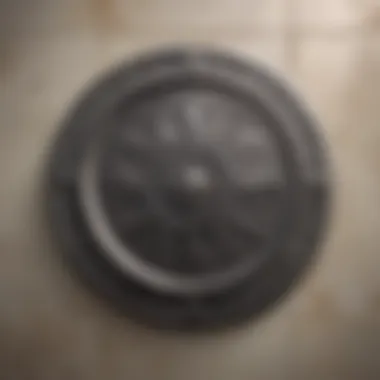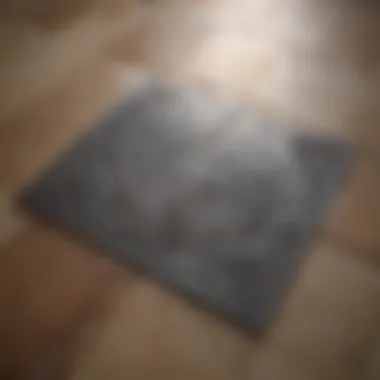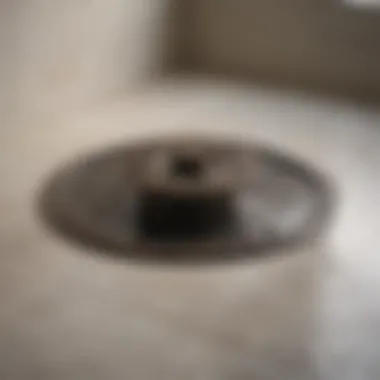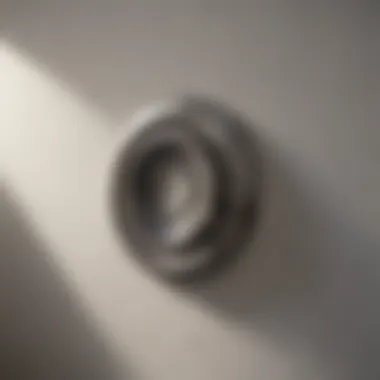Understanding Bath Shower Drain Covers: A Comprehensive Guide


Intro
In the realm of home improvement, selecting the right bath shower drain cover is often overlooked. Yet, it is a crucial aspect that not only affects functionality but also enhances the overall aesthetic appeal of the bathroom. A well-chosen drain cover can complement the design of your space, while a poorly fitted one can lead to drainage issues and even unpleasant odors. This article aims to demystify the selection, installation, and maintenance of bath shower drain covers, providing a comprehensive guide for housewives and homeowners alike.
Understanding the various styles available today can profoundly impact your choice. It provides insight into how these covers can align with your personal taste, ultimately creating a serene bathing environment. Moreover, maintaining these covers ensures their longevity and proper function.
Through this exploration, we will cover trending styles, suitable color palettes, and essential maintenance tips that will assist you in making informed decisions.
Intro to Bath Shower Drain Covers
Bath shower drain covers serve multiple essential functions in a bathroom environment. They are not merely aesthetic elements; they play a critical role in preventing debris from entering the plumbing system. Effective drain covers minimize clogs, ensuring a smooth flow of water. This aspect alone makes them indispensable in both residential and commercial settings. Moreover, the benefits extend beyond functionality to include aspects of safety and cleanliness. A properly secured and maintained drain cover can prevent accidents, such as slips or falls, in wet areas.
In addition to their practical applications, bath shower drain covers contribute significantly to the overall aesthetic of a bathroom. Homeowners are increasingly aware that every detail matters in creating a coherent design. Choosing the right cover can tie together a room's style, enhancing either a modern look or a more traditional ambiance.
Protecting plumbing systems and improving the visual appeal of a bathroom are just two reasons why it is essential to understand bath shower drain covers. This article will guide you through the various types available, help in selecting the appropriate cover, and provide insights into installation and maintenance. Such knowledge empowers homeowners to make informed choices that both elevate functionality and enhance the beauty of their bath spaces.
The Function of Drain Covers
The primary function of bath shower drain covers is straightforward yet vital: they prevent large debris—like hair, soap residue, and other materials—from clogging the drain. Clogs can lead to significant plumbing issues, including backups and leaks, which can be both costly and inconvenient to resolve.
In addition to blocking debris, drain covers serve the purpose of protecting the plumbing from unintended objects, such as small toys or personal items that might accidentally fall into the drain. This added layer of protection directly impacts the longevity of the plumbing system. They also help in directing water flow into the drainage system, promoting efficient drainage and reducing the risk of standing water, which can become a breeding ground for bacteria and mold.
Aesthetic Considerations
Bath shower drain covers are available in a wide variety of styles and finishes. They can be chosen not only for their functionality but also for how they complement the overall design of the bathroom. A stylish drain cover can merge aesthetics with practicality.
When selecting a drain cover, consider its finish. Options include chrome, bronze, stainless steel, and plastic. Each material offers a different look and feel, fitting varying decor styles from contemporary to rustic. Additionally, decorative drain covers can function as statement pieces, subtly enhancing the bathroom's atmosphere.
Key Aesthetic Points to Consider:
- Finish: Select a finish that harmonizes with other bathroom fixtures.
- Style: Choose between modern sleek designs or classic patterns.
- Color: Ensure the color blends well with the overall color scheme of the bathroom.
Overall, while the functionality of drain covers is crucial, their contribution to visual appeal should not be overlooked. Their selection allows one to enhance a bathroom's ambiance while maintaining practical drainage solutions.
Types of Bath Shower Drain Covers
Understanding the different types of bath shower drain covers is essential for homeowners seeking functionality and design in their bathrooms. Each type of cover serves its own purpose, offering benefits that cater to specific needs and preferences. Choosing the proper type can enhance both usability and aesthetics, making it an important aspect of bath renovation or maintenance.
Standard Metal Covers
Standard metal covers are among the most traditional options available. These covers are typically made from stainless steel or brass. Their durability is a notable advantage, as they resist corrosion and wear over time. This quality is particularly vital in wet environments like bathrooms.
In terms of aesthetics, standard metal covers can blend seamlessly with various design styles. They often come in polished or brushed finishes, providing a sleek and clean look that complements contemporary designs. However, maintenance is essential; regular cleaning keeps them shiny and free from rust spots.
Plastic Drain Covers
Plastic drain covers are often seen as a more budget-friendly alternative. Made from durable polymers, these covers are lightweight and come in a wide variety of colors and designs. Unlike their metal counterparts, plastic covers resist rust and can be less prone to scratches.
One significant benefit of using plastic drain covers is ease of installation. They are typically designed to fit standard drain sizes without the need for additional hardware. However, potential drawbacks include a shorter lifespan and less heat resistance compared to metal options. Selecting a high-quality plastic cover can mitigate some of these concerns.


Decorative Drain Covers
Decorative drain covers are designed primarily for aesthetics rather than functionality. These covers come in various styles, materials, and patterns. Some may feature intricate designs or even be customizable to match a specific bathroom theme.
While they can enhance the overall look of your bath, it’s essential to ensure that these decorative options do not compromise drainage efficiency. When selecting a decorative cover, homeowners should consider how well it will integrate with the plumbing and whether it can withstand frequent usage.
Anti-Clogging Drain Covers
Anti-clogging drain covers are engineered to prevent debris from entering the drain, reducing maintenance needs. These covers often incorporate unique designs, such as mesh or slotted patterns, strategically allowing water to pass while trapping hair and other materials.
The primary advantage of an anti-clogging cover is less frequent plumbing issues, which can save homeowners significant time and money. While they may not always offer the same design flexibility as other types, their practical benefits are hard to ignore. Homeowners should assess their specific drainage issues when considering this option.
Selecting the Right Drain Cover
Selecting the right drain cover is a critical step in ensuring both functionality and visual appeal of your bathroom. An appropriate drain cover can help to prevent clogs, enhance the safety of your bathroom, and contribute to its overall design. This section breaks down the essential factors to consider when choosing a drain cover.
Material Considerations
Durability
Durability is a key aspect when selecting a drain cover. Drain covers made of high-quality materials tend to withstand the constant exposure to water and cleaning agents. Metal covers, particularly stainless steel, are known for their strength. They resist impact, which means they are less likely to become damaged over time. However, options such as plastic may not provide the same level of durability but are often lighter and easier to handle.
A key characteristic of durability is its longevity. A durable drain cover reduces the need for frequent replacements, saving money and time in the long run.
In this article, durability is highlighted because it impacts the reliability of the drainage system. A cover that can endure wear and tear is a beneficial choice for homeowners who seek efficiency and lower maintenance.
Corrosion Resistance
Corrosion resistance is another important feature. Drain covers often face moisture which can lead to rust or corrosion, particularly with metal materials. Stainless steel is often chosen for its excellent corrosion resistance. Not only does it protect the integrity of the cover, but it maintains its appearance over time.
The key characteristic here is the ability of the material to resist degrading due to environmental elements. This makes corrosion-resistant covers ideal for bathrooms, where humidity levels can be high. In our article, emphasizing corrosion resistance is beneficial because it leads to better performance and a longer lifespan for the drain cover.
Size and Compatibility
Standard Sizes
Standard sizes are a common choice for many homeowners. These covers are typically designed to fit common drain openings found in most bathrooms. By selecting a standard size, you can ensure that installation is straightforward, and compatibility with existing plumbing is usually assured.
This is a beneficial aspect of standard sizes since they eliminate the complexity of custom fittings and reduce potential installation errors. Often listed dimensions make it easy to choose.
Yet, while standard sizes are convenient, they may not fit all unique setups. Custom options can provide a better fit for more unique or older installations.
Custom Options
Custom options come into play when standard sizes do not quite fit your specific needs. For older homes or uniquely designed bathrooms, a custom drain cover can provide a precise fit, enhancing both aesthetic and functionality.
A key characteristic of custom options is their ability to adapt to any specific size or design requirement. While more costly, they ensure a perfect match for your drain opening, reducing leaks and enhancing safety.
Custom covers might require more time for production and delivery. However, for many, these little compromises are worth it to achieve a polished look.
Design and Finish


Modern Styles
Modern styles lean towards minimalist design and sleek finishes. Selecting a drain cover in a modern style can significantly enhance the bathroom's overall aesthetic, aligning with contemporary design choices. Modern covers often incorporate geometric shapes and smooth lines, making them visually appealing.
A key characteristic of modern styles is their ability to integrate seamlessly with newer bathroom fixtures and trends. This makes them a favorable choice for homeowners looking to maintain a cohesive look.
While modern covers are stylish, they may not suit more traditional or classic designs. It's important to consider the existing decor and fixtures before making a choice.
Classic Designs
Classic designs offer timeless elegance, appealing to those who favor traditional aesthetics. Drain covers with ornate patterns or vintage finishes can enhance the charm of a bathroom.
The key characteristic of classic designs is their ability to evoke a sense of nostalgia and warmth. This can be particularly appealing in more traditional or rustic-style homes. In the context of this article, classic designs stand out as a beneficial choice for those striving for a cohesive, historical appearance.
However, classic styles could clash with modern fixtures and may require careful selection to ensure compatibility in style and finish.
Selecting the right drain cover is more than just a functional decision; it is also about enhancing the overall look of your bathroom. Understanding materials, size, and design can make a significant difference in the final outcome.
Installation of Bath Shower Drain Covers
Installing bath shower drain covers is a critical task that impacts not only the functionality of drainage systems but also the overall aesthetics of bathrooms. Proper installation ensures that water flows unimpeded, preventing clogs and potential water damage. Moreover, well-fitted covers enhance the visual appeal of the bath area, making it look polished and inviting. Understanding the correct practices for installation can lead to prolonged lifespan and optimal operation of the drainage system.
Preparation Steps
Gathering Tools
Before starting the installation process, one must gather the right tools. This step is pivotal as it facilitates a smooth workflow. Basic tools needed include a screwdriver, measuring tape, and possibly pliers. Each of these tools serves a specific purpose. For example, a screwdriver is necessary for securing the drain cover, while pliers may be useful for adjusting components. Having these tools handy allows for a more efficient installation experience. It reduces interruptions, thus allowing one to focus on ensuring precision in the work.
Removing Old Covers
In most cases, an old drain cover must be removed before installing a new one. This task is significant as it sets the stage for a successful installation. The typical characteristic of removing old covers involves unscrewing or prying them loose. It is a popular choice to replace outdated or damaged covers. Undertaking this step prevents future issues related to improper fittings and promotes better water flow. However, caution is essential; if the old cover is corroded, it may break easily, creating debris. Thus, careful removal ensures a clean slate for the new installation.
Step-by-Step Installation Guide
Aligning the Cover
One crucial aspect of the installation process is aligning the cover properly. This task contributes directly to the drainage system’s efficiency. Proper alignment ensures that the cover fits snugly and securely over the drain. If misaligned, water may not drain effectively, leading to potential backups. Attention to detail during this step is beneficial, as it promotes a long-lasting installation. Moreover, it helps in maintaining the aesthetic integrity of the bathroom.
Securing with Screws
After aligning the cover, the next step is to secure it with screws. This step is fundamental to ensuring that the drain cover remains in place and does not become dislodged over time. Using quality screws is recommended to provide a strong hold. The unique feature of securing with screws is that it mitigates the possibility of water intrusion effectively. However, overtightening can be a disadvantage as it may crack the cover or strip the threads. Thus, a balanced approach is advisable during this final step of installation.
Proper installation of bath shower drain covers is essential to ensure not only function but also aesthetic harmony in your bathroom space.
Maintenance of Drain Covers
Proper maintenance of drain covers is crucial for extending their lifespan and ensuring they perform optimally. A neglected drain cover can lead to various problems, including clogs and even water damage. Additionally, maintaining these fixtures ensures a clean and functional bathroom environment. Regular upkeep is a practical approach that prevents larger expenses or repairs down the line.
Cleaning Techniques
Removing Debris


One of the most essential aspects of maintaining a bath shower drain cover is removing debris. This process enhances the overall functionality of the drainage system. A clean cover facilitates better water flow, reducing the likelihood of clogging.
Removing debris is particularly beneficial because it prevents the accumulation of hair, soap residue, and other particles that can obstruct drainage. Regular removal can also prolong the life of the drain cover itself, as buildup can lead to rust or corrosion over time. Consider a simple practice of lifting the cover and clearing out the debris at least once a week. This minor task can significantly improve your drainage experience.
Safe Cleaning Agents
Using safe cleaning agents is critical for the maintenance of drain covers. Cleaning agents should be effective without causing harm to the material of the drain cover. Natural solutions like vinegar or baking soda are popular choices. They are gentle on most materials while still providing effective cleaning.
A key feature of safe cleaning agents is that they help to avoid harsh chemicals that may damage the drain shape or finish. By choosing safer alternatives, you not only protect the materials but also contribute to a healthier bathroom environment. However, it is essential to verify that any cleaning agent used is appropriate for the specific material of your drain cover.
Replacement Indicators
Replacement indicators help in determining when it is time to change a drain cover. Recognizing when to replace a cover is essential for maintaining a functional drainage system. Various factors can suggest that a cover has reached the end of its useful life.
When to Replace
Knowing when to replace a drain cover can save time and prevent complications. Typically, replacing a drain cover is necessary if it shows significant signs of damage, such as cracks or bends. These issues can lead to further complications, such as leaks or ineffective drainage.
A key characteristic of a drain cover needing replacement is the extent of damage visible. If the cover is warped or may not sit flush against the shower floor, it can allow water escape, which may lead to larger repairs. Generally, it is beneficial to inspect your drain cover regularly and consider replacement if it looks significantly worn or is not functioning as intended.
Signs of Wear and Tear
Understanding signs of wear and tear is also necessary. Common signs include discoloration, rust, or material degradation. Identifying these signs early can help avoid more significant problems that require more extensive repairs or replacements.
One important characteristic of worn drain covers is their reduced efficacy. A cover that cannot keep up with normal water flow can derail your entire bathing experience. Regular monitoring helps catch these issues before they escalate, making it an advantageous practice for homeowners seeking to maintain an efficient and appealing bathroom.
Environmental Considerations
Understanding the environmental impact of bath shower drain covers is essential for both homeowners and designers aiming to make informed decisions. This consideration extends beyond aesthetics and functionality, supporting sustainable practices that benefit our planet. In recent years, there has been a noticeable shift towards eco-friendly materials and practices within the home improvement industry. By being aware of these elements, individuals can contribute positively to the environment while still achieving a desirable bathroom design.
Sustainable Materials
Choosing sustainable materials for drain covers contributes significantly to reducing environmental footprints. Many drain covers are made from metals such as stainless steel or high-grade aluminum, which are durable and recyclable. For instance, stainless steel is resistant to rust and corrosion, allowing it to maintain functionality for a long time. In addition, some manufacturers now offer drain covers made from recycled plastics. This not only diverts waste from landfills but also provides a lightweight and cost-effective option.
When considering sustainable materials, the manufacturing process must also be examined. Opting for companies that prioritize environmentally friendly production methods can make a notable difference. Customers should look for certifications that indicate responsible sourcing or eco-friendly practices. This could include materials that are locally sourced, reducing the carbon footprint associated with transportation.
Water Conservation Practices
Water conservation is another vital aspect related to bath shower drain covers. In addition to their function, certain designs can help minimize water wastage. For example, installing covers that incorporate efficient drainage systems can reduce standing water, which prevents potential overuse of water pumps. Furthermore, selecting barriers that are correctly sized can prevent clogs and ensure smooth water flow, thus enhancing the overall efficiency of the shower.
Adopting practices such as fixing leaks promptly and utilizing low-flow showerheads can complement the installation of effective drain covers. This holistic approach to water management not only contributes to lower water bills but also supports global efforts to conserve this precious resource.
"Responsible choices in home design not only enhance a space's aesthetic but also ensure a sustainable future for generations to come."
Embracing these environmental considerations when choosing and maintaining bath shower drain covers fosters a cleaner ecosystem. Educating oneself about the options available will allow homeowners to enhance both the functionality and sustainability of their bathrooms.
Closure
In closing, it is crucial to acknowledge the significant role that bath shower drain covers play in both functionality and aesthetics of a bathroom. This article focused on key areas such as types of drain covers, selection criteria, installation methods, and maintenance procedures. Each point discussed not only serves to inform homeowners but also encourages a thoughtful approach to bathroom design and upkeep.
Selection of the right drain cover is fundamental. The material, size, design, and finish all contribute to the overall harmony of the bathroom. Choosing between standard metal covers and decorative ones can have an impact on both durability and style. Understanding these distinctions allows homeowners to make choices that suit their needs and preferences.
Installation is another important aspect. Proper installation ensures that the cover functions effectively, preventing clogs and maintaining a clean environment. Following a systematic guide to installation can often mitigate future issues, making it a crucial phase in the process of renovation or maintenance.
Maintenance cannot be overlooked. Regular cleaning and recognizing when to replace drain covers can significantly enhance the longevity and performance of these fixtures. Homeowners should regularly inspect their covers for wear and tear and apply the right cleaning techniques to prolong their lifespan.
Overall, the thoughtful consideration of these elements leads to a more serene bath environment. With careful selection, precise installation, and diligent maintenance, drain covers become more than mere functional objects; they evolve into integral components of a stylish and practical bathroom. This article underscores the importance of being educated on these topics as they enhance both the utility and aesthetic appeal of the home.















